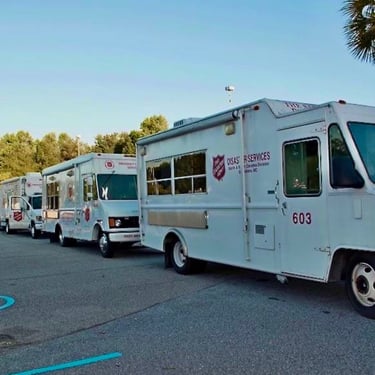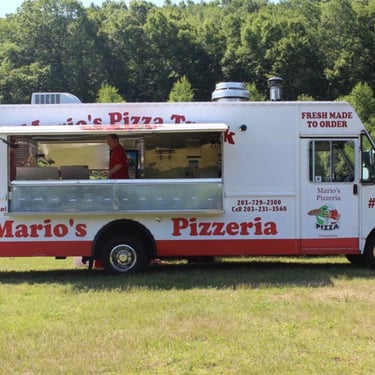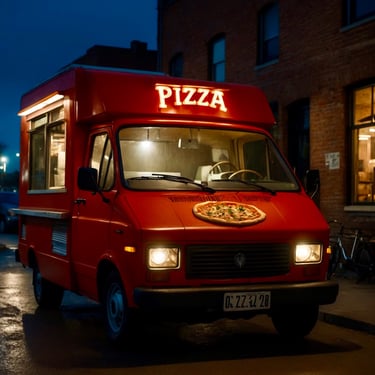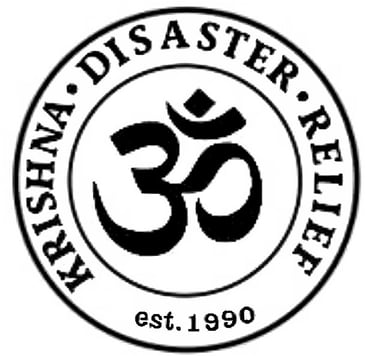Providing FREE vegetarian meals during times of natural disasters
Lord Krishna in the 21st Century


Chapter 23 - Responding to Disasters in America
Writing this book has definitely led me to address many areas of interest that I had either inadvertently glossed over or never considered. The subject matter here is rather immense and very important.
Additionally, for Krishna Disaster Relief to work it needs to be practical. Nobody likes a plan that is too far-fetched.
Part of this plan was explained in chapter 17: "Show Me The Money." Here the idea was mentioned of having Krishna Disaster Relief's name and 1-800 number included inside every "How To Help" donation box. I have also said that here in America we should begin our response to disasters with drinking water. Incidentally, in other countries, too, Krishna Disaster Relief may wish to begin this way.
Overall, our blueprint needs to be pursued vigorously: People love heroes. By showing Krishna coming to the rescue, over time the entire world will stand up and give Him a tremendous applause. I know that Shrila Prabhupada would be very pleased.
Creating this blueprint in book form, I know that a serious discussion about the specifics I've mentioned mentioned will clarify the many issues I have brought up.
(Again, I wrote these thought down many years ago): Could it be, for instance, that just a single temple who wants to support Krishna Disaster Relief be sufficient to start as a test or pilot project? I'm still concerned about our disaster-relief efforts in America. Please allow me to just say what comes to mind for the sake of my own clarity.
Ideally, I have already said that I would like to see Krishna Disaster Relief headquartered at the Potomac, Maryland temple. Eventually a proper building could be built on the property for Krishna Disaster Relief to use. It could be designed very nicely to give it the mood and appearance of a disaster-relief facility; a place for several vehicles to be parked inside, storage, classrooms, offices, etc. Like a modern fire station.
During certain emergencies it would be from the Potomac temple that a specific Krishna Disaster Relief team would depart. Of course, it would also be here that Krishna Disaster Relief would have its offices; doing and managing all the things that I have been suggesting. From here, Krishna Disaster Relief could hold its own annual meetings where like-minded friends from all over the world could attend.
This facility would also give us the opportunity to host meetings where disaster-relief volunteers from other organizations could meet; from the Maryland, Virginia, and other state VOAD teams.
As I said, it would be from here that a Krishna Disaster Relief team would leave to respond to actual disasters. However, to cover the United States properly, at least three other staging areas need to be established. One in the Southern part of the United States (perhaps in Florida); one in the West (California); and one in Texas or Colorado. More can be added.
The need for mobility is rather obvious. Mobility means vehicles and in this regards I have a couple of thoughts. Having been to several major disasters, myself, I have given this subject considerable attention.
Using the Limon-Colorado tornado as a good example, the most significant thing about a disaster is the complete devastation. Everything is broken and ruined. In stark contrast to this and providing the dazed victims their first sense of stability, are the things brought onto the "stage" by the various "actors."
Everything may be destroyed, but over there sits a new vehicle, brought to the scene by a disaster-relief agency. It isn't smashed. This vehicle is clean, strong and a welcome sight.
I'm concerned about how Krishna Disaster Relief will look to the public. I told you how our beat up Food for Life van in Denver looked more like a drug deal going down rather than the Krishna feeding the homeless. We definitely want to avoid showing up to a disaster in a vehicle that already looks like it has been in a disaster.
Instead, when Krishna Disaster Relief arrives, we should only have the best. Specifically, the kind of vehicles that Krishna Disaster Relief needs are shown in this chapter's photos. I also feel that as much as possible everything we have should look the same, or at minimum, with our logo plainly visible. Not a hodgepodge but rather the same make, style, color, etc; much like the Salvation Army.
Perhaps the Ford Motor Company can donate some vehicles to Krishna Disaster Relief. Government grants are also possible. However this is accomplished, Krishna Disaster Relief needs some new, reliable trucks. They should all be white in color with our beautiful Krishna Disaster Relief logo painted on it. If we start by distributing water, then our logo would also be painted on our trailers. Who knows, maybe a water-bottling company would print Krishna Disaster Relief labels on our own bottles. (5/19/25: I've looked into this possibility and there is a water-bottling company in San Antonio, Texas that provide this exact thing.)
About signs: we want them but let's not overdue it. Some thought needs to go into this. We want to avoid the appearance of "grandstanding." I like the modest approach. For those interested in what we are doing, our pamphlets and business cards will suffice.
If Krishna Disaster Relief starts with simple water distribution, our trucks can be fitted with campers that would give each disaster-relief team the mobility, appearance and shelter that we would need. If maintained properly, they would give Krishna Disaster Relief many years of service. In each locale (wherever they are kept) they should be stored in a garage of some kind. A type of carport or garage can be purchased and would extend their life.
Regarding the 8 foot, cab-over campers, they are both compact and fully self-contained, meaning a bathroom, kitchen, beds, storage, etc. It is rather amazing how much they have been able to build into these condensed units. There are several manufacturers of these cab-over campers to choose from. Some thought needs to go into all of this, as far as what is finally purchased. To save money, buying four identical units at once will give us leverage. But again, all four need to be the same in make, color, and with our logo.
As far as the means to provide drinking water, each truck can pull a custom built trailer to store and transport the water. Of course there are pros and cons to consider and again I realize that there details to discuss, but this gives you some of the basic ideas that I have.
Smaller water bottles are more convenient to pass out. Besides our own labeled water, I can imagine how we could get an unlimited supply of these donated to us, and this is quality water that has a long shelf-life. We need to take a very close look at this bottled-water idea; talk to the professions in the water industry; amongst ourselves, etc.
People just generally like and respect disaster-relief agencies. Krishna Disaster Relief could contact the owners of water bottling companies and work out a convenient arrangement. Here in Texas, HEB is the best known grocery store. HEB has many warehouses where their water is stored. So there is the good possibility that not only would HEB donate the water to us but would let us come directly to their warehouses to pick up water on the way to a disaster.
True, there are many details to work out here but just imagine the logistics and difficulties and details involved in deploying a mobile food kitchen. Providing just water is a much simpler approach.
A serious discussion about this needs to take place. Perhaps water isn't the answer. I love the idea of mobile pizza trucks.



#1. Photo of all the Salvation Army disaster-relief food trucks from the Jacksonville Daily Record.
#2. Photo of pizza truck from the manufacturer: www.foodtruckempire.com.
#3. Red Pizza truck created by Leonardo Ai by the author.


